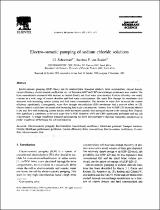JavaScript is disabled for your browser. Some features of this site may not work without it.
- ResearchSpace
- →
- Research Publications/Outputs
- →
- Journal Articles
- →
- View Item
| dc.contributor.author |
Schoeman, JJ

|
en_US |
| dc.contributor.author |
van Staden, JF

|
en_US |
| dc.date.accessioned | 2007-02-08T07:47:20Z | en_US |
| dc.date.accessioned | 2007-06-07T10:03:46Z | |
| dc.date.available | 2007-02-08T07:47:20Z | en_US |
| dc.date.available | 2007-06-07T10:03:46Z | |
| dc.date.copyright | en_US | |
| dc.date.issued | 1997-08-20 | en_US |
| dc.identifier.citation | Schoeman, JJ and van Staden, JF. 1997. Electro-osmotic pumping of sodium chloride solutions. Journal of Membrane Science, vol 132(1), pp 1-21 | en_US |
| dc.identifier.uri | http://hdl.handle.net/10204/1650 | en_US |
| dc.identifier.uri | http://hdl.handle.net/10204/1650 | |
| dc.description.abstract | Electro-osmotic pumping (EOP) theory and its characteristics (transport numbers, brine concentration, current density, current efficiency, electro-osmotic coefficients, etc.) of Selemion AMV and CMV ion-exchange membranes were studied. The brine concentration increased with increase in current density and feed water concentration. Current efficiency was nearly constant in a wide range of current densities and feed water concentrations. The water flow through the membranes also increased with increasing current density and feed water concentration. The increase in water flow increased the current efficiency significantly. Consequently, water flow through electrodialysis (ED) membranes had a positive effect on ED. Electro-osmotic coefficients decreased with increasing feed water concentration. Osmotic flow in EOP-ED decreased relative to the total flow with increasing current density while the electro-osmotic flow increased relative to the osmotic flow. Osmotic flow significantly contributes to the total water flow in EOP. Selemion AMV and CMV membranes performed well for salt concentration. A simple membrane potential measurement has been demonstrated to function reasonably satisfactorily to predict membrane performance for salt concentration | en_US |
| dc.format.extent | 1213264 bytes | en_US |
| dc.format.mimetype | application/pdf | en_US |
| dc.language.iso | en | en_US |
| dc.publisher | Elsevier Science BV | en_US |
| dc.rights | Copyright: 1997 Elsevier Science BV | en_US |
| dc.source | en_US | |
| dc.subject | Electro-osmotic pumping theories | en_US |
| dc.subject | Brine concentrations | en_US |
| dc.subject | Ion-exchange membranes | en_US |
| dc.subject | Electro-osmotic coefficients | en_US |
| dc.subject | Chemical engineering | en_US |
| dc.subject | Polymer sciences | en_US |
| dc.subject | Feed water concentrations | en_US |
| dc.title | Electro-osmotic pumping of sodium chloride solutions | en_US |
| dc.type | Article | en_US |
| dc.identifier.apacitation | Schoeman, J., & van Staden, J. (1997). Electro-osmotic pumping of sodium chloride solutions. http://hdl.handle.net/10204/1650 | en_ZA |
| dc.identifier.chicagocitation | Schoeman, JJ, and JF van Staden "Electro-osmotic pumping of sodium chloride solutions." (1997) http://hdl.handle.net/10204/1650 | en_ZA |
| dc.identifier.vancouvercitation | Schoeman J, van Staden J. Electro-osmotic pumping of sodium chloride solutions. 1997; http://hdl.handle.net/10204/1650. | en_ZA |
| dc.identifier.ris | TY - Article AU - Schoeman, JJ AU - van Staden, JF AB - Electro-osmotic pumping (EOP) theory and its characteristics (transport numbers, brine concentration, current density, current efficiency, electro-osmotic coefficients, etc.) of Selemion AMV and CMV ion-exchange membranes were studied. The brine concentration increased with increase in current density and feed water concentration. Current efficiency was nearly constant in a wide range of current densities and feed water concentrations. The water flow through the membranes also increased with increasing current density and feed water concentration. The increase in water flow increased the current efficiency significantly. Consequently, water flow through electrodialysis (ED) membranes had a positive effect on ED. Electro-osmotic coefficients decreased with increasing feed water concentration. Osmotic flow in EOP-ED decreased relative to the total flow with increasing current density while the electro-osmotic flow increased relative to the osmotic flow. Osmotic flow significantly contributes to the total water flow in EOP. Selemion AMV and CMV membranes performed well for salt concentration. A simple membrane potential measurement has been demonstrated to function reasonably satisfactorily to predict membrane performance for salt concentration DA - 1997-08-20 DB - ResearchSpace DP - CSIR KW - Electro-osmotic pumping theories KW - Brine concentrations KW - Ion-exchange membranes KW - Electro-osmotic coefficients KW - Chemical engineering KW - Polymer sciences KW - Feed water concentrations LK - https://researchspace.csir.co.za PY - 1997 T1 - Electro-osmotic pumping of sodium chloride solutions TI - Electro-osmotic pumping of sodium chloride solutions UR - http://hdl.handle.net/10204/1650 ER - | en_ZA |






